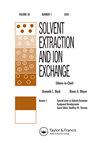Microemulsion as Model to Predict Free Energy of Transfer of Electrolyte in Solvent Extraction
IF 2.1
4区 化学
Q3 CHEMISTRY, MULTIDISCIPLINARY
引用次数: 4
Abstract
ABSTRACT We consider here the extraction of metals in the form of salts transferred from an aqueous to a solvent phase. Extraction is triggered by complexation and quenched by the associated necessary reorganization of the structured solvent phase. The extraction of ions changes the relative fraction of extractant molecules that is not part of the highly curved surfactant monolayer and is dispersed molecularly in the oil, and also the polar volume fraction including co-extracted water. The free energy and corresponding microstructures of the water-poor microemulsions are modelled in the frame of the Gaussian random fields (GRF) model. The curvature frustration energy significantly contributes to the free energy of extraction. A typical example of predicted isotherm using the GRF model is compared to the classically considered supramolecular complex formation, together with a minimal Langmuir model and an explicit monomer-to-film equilibrium of amphiphilic extractant. The corresponding small-angle scattering spectra and morphology changes are shown. One implication is that selectivity between a hydrated and a non-hydrated species is concentration dependent and cannot be considered as a constant as a function of the extractant concentration.用微乳液模型预测溶剂萃取过程中电解质的自由转移能
摘要我们在这里考虑以盐的形式从水相转移到溶剂相中提取金属。萃取通过络合触发,并通过相关的结构化溶剂相的必要重组而猝灭。离子的提取改变了不属于高度弯曲的表面活性剂单层并分子分散在油中的提取剂分子的相对分数,也改变了包括共提取水的极性体积分数。在高斯随机场模型的框架下,对贫水微乳液的自由能和相应的微观结构进行了建模。曲率挫败能对提取的自由能有显著贡献。使用GRF模型预测等温线的一个典型例子与经典的超分子络合物形成,以及最小Langmuir模型和两亲性萃取剂的显式单体-膜平衡进行了比较。显示了相应的小角度散射光谱和形貌变化。一个含义是,水合物种和非水合物种之间的选择性取决于浓度,不能被视为萃取剂浓度的函数常数。
本文章由计算机程序翻译,如有差异,请以英文原文为准。
求助全文
约1分钟内获得全文
求助全文
来源期刊
CiteScore
4.40
自引率
5.00%
发文量
15
审稿时长
8.4 months
期刊介绍:
Solvent Extraction and Ion Exchange is an international journal that publishes original research papers, reviews, and notes that address all aspects of solvent extraction, ion exchange, and closely related methods involving, for example, liquid membranes, extraction chromatography, supercritical fluids, ionic liquids, microfluidics, and adsorption. We welcome submissions that look at: The underlying principles in solvent extraction and ion exchange; Solvent extraction and ion exchange process development; New materials or reagents, their syntheses and properties; Computational methods of molecular design and simulation; Advances in equipment, fluid dynamics, and engineering; Interfacial phenomena, kinetics, and coalescence; Spectroscopic and diffraction analysis of structure and dynamics; Host-guest chemistry, ion receptors, and molecular recognition.

 求助内容:
求助内容: 应助结果提醒方式:
应助结果提醒方式:


